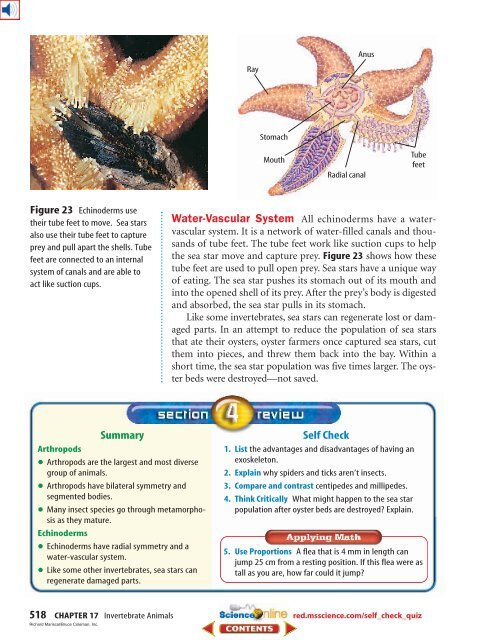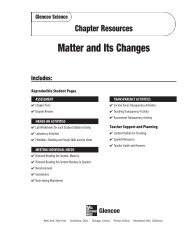Chapter 17: Invertebrate Animals
Chapter 17: Invertebrate Animals
Chapter 17: Invertebrate Animals
Create successful ePaper yourself
Turn your PDF publications into a flip-book with our unique Google optimized e-Paper software.
Ray<br />
Anus<br />
Stomach<br />
Mouth<br />
Radial canal<br />
Tube<br />
feet<br />
Figure 23 Echinoderms use<br />
their tube feet to move. Sea stars<br />
also use their tube feet to capture<br />
prey and pull apart the shells. Tube<br />
feet are connected to an internal<br />
system of canals and are able to<br />
act like suction cups.<br />
Water-Vascular System All echinoderms have a watervascular<br />
system. It is a network of water-filled canals and thousands<br />
of tube feet. The tube feet work like suction cups to help<br />
the sea star move and capture prey. Figure 23 shows how these<br />
tube feet are used to pull open prey. Sea stars have a unique way<br />
of eating. The sea star pushes its stomach out of its mouth and<br />
into the opened shell of its prey. After the prey’s body is digested<br />
and absorbed, the sea star pulls in its stomach.<br />
Like some invertebrates, sea stars can regenerate lost or damaged<br />
parts. In an attempt to reduce the population of sea stars<br />
that ate their oysters, oyster farmers once captured sea stars, cut<br />
them into pieces, and threw them back into the bay. Within a<br />
short time, the sea star population was five times larger. The oyster<br />
beds were destroyed—not saved.<br />
Summary<br />
Arthropods<br />
•<br />
Arthropods are the largest and most diverse<br />
•<br />
group of animals.<br />
Arthropods have bilateral symmetry and<br />
•<br />
segmented bodies.<br />
Many insect species go through metamorphosis<br />
as they mature.<br />
•<br />
Echinoderms<br />
Echinoderms have radial symmetry and a<br />
•<br />
water-vascular system.<br />
Like some other invertebrates, sea stars can<br />
regenerate damaged parts.<br />
Self Check<br />
1. List the advantages and disadvantages of having an<br />
exoskeleton.<br />
2. Explain why spiders and ticks aren’t insects.<br />
3. Compare and contrast centipedes and millipedes.<br />
4. Think Critically What might happen to the sea star<br />
population after oyster beds are destroyed Explain.<br />
5. Use Proportions A flea that is 4 mm in length can<br />
jump 25 cm from a resting position. If this flea were as<br />
tall as you are, how far could it jump<br />
518 CHAPTER <strong>17</strong> <strong>Invertebrate</strong> <strong>Animals</strong><br />
Richard Mariscal/Bruce Coleman, Inc.<br />
red.msscience.com/self_check_quiz














